For many new parents, routine newborn procedures are something they’ve not given much thought to… yet. In this article I hope to describe the benefits of an undisturbed first hour after birth and the pros and cons of routine newborn procedures that occur during this sensitive time.
Don’t let the first hour of birth pass you by! Become educated, create a plan for routine newborn procedures and enjoy the first hour of birth as as things unfold.
In this post I will not be discussing the following procedures, however, please take the time to research and discuss each intervention with your care provider. They’re a big deal and not to be taken lightly!
- Circumcision
- Hepatitis B Vaccine
- Vitamin K (often administered during the first hour)
- PKU Heel Prick
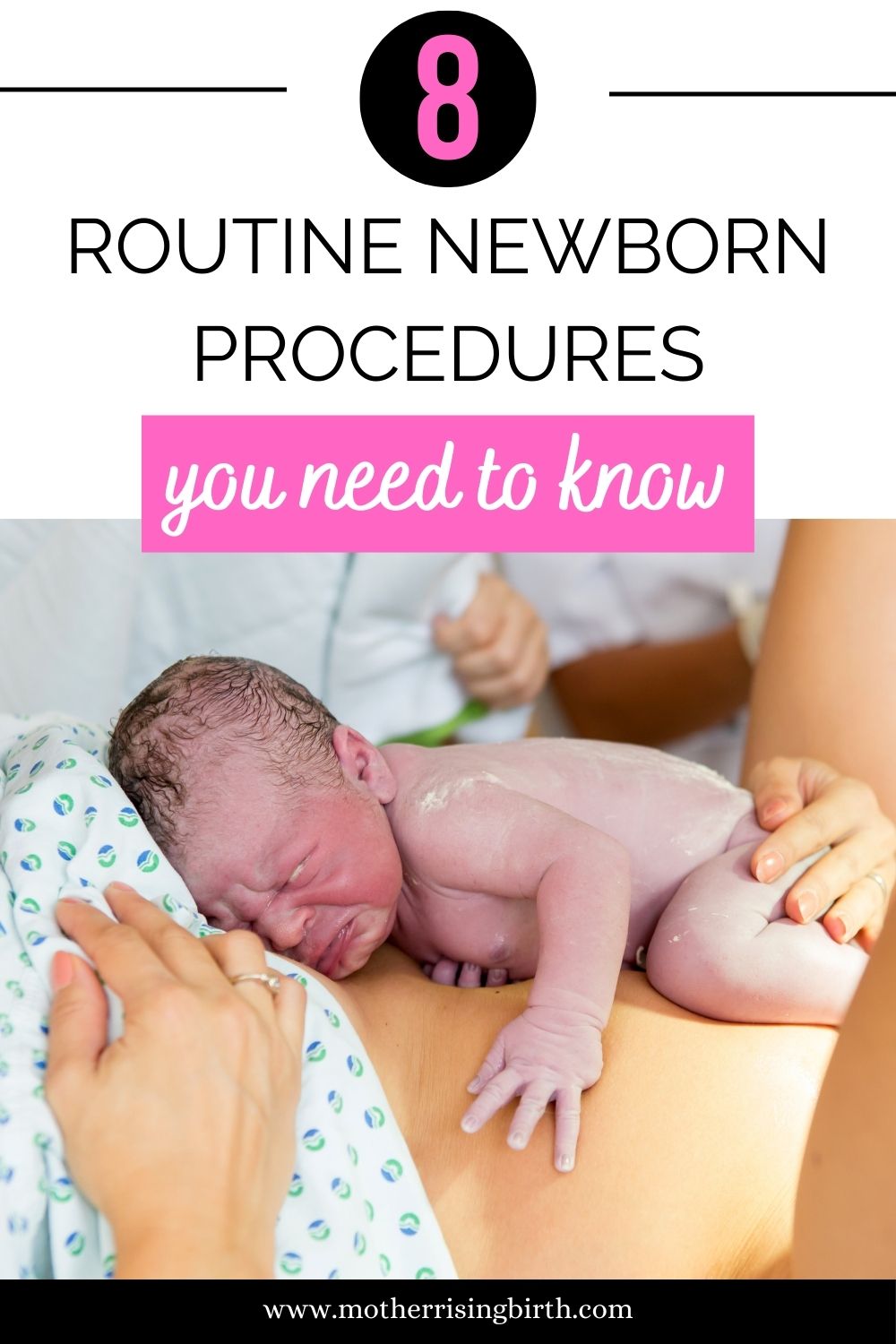
The First Hour After Birth
Assuming everyone is healthy, it is ideal for mom and baby to be together, skin-to-skin, uninterrupted for a minimum of an hour after birth. An hour is ideal, but more time can be helpful too. (Not every baby latches on in less than 60 minutes.)
Immediately following birth, mom and baby will have peak amounts of oxytocin, a hormone referred to as “the hormone of love”, coursing through their bodies. Oxytocin, an important part of the birthing process, plays a crucial role after birth as well. Oxytocin promotes bonding, breastfeeding and even helps prevent postpartum hemorrhage.
During the first hour after birth, vitals (temperature, heart rate, respirations, etc.) can usually be done while baby is on mom and routine newborn procedures can be pushed back to a less time sensitive moment. Just as it’s critical for babies to transition to using their lungs, it’s critical for the mother-baby bonding process to unfold.
Other benefits of an undisturbed first hour are temperature regulation, breathing regulation, and better blood glucose readings. (SOURCE)
Again, assuming a healthy mom and baby, it can be helpful for birth attendants to take a deep breath, calm their bodies, and refocus to slow down the energy in the room after birth. Dim the lights, set the thermostat to a warm temperature, and observe what happens.
NEXT BEST THING: If for whatever reason mom cannot do skin-to skin with baby, the next best thing is dad, or another birth companion, to do it instead. Dads can take their shirts off, place baby on their chest and cover baby with a warm receiving blanket.
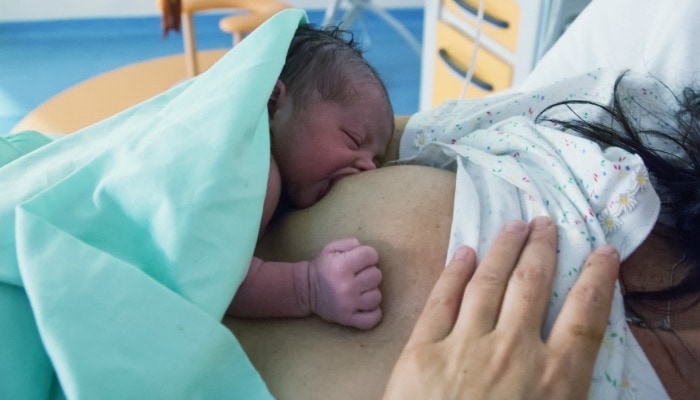
8 Routine Newborn Procedures You Need to Know About
The following routine newborn procedures should be evaluated carefully when deciding how to spend that first hour after birth. Your baby will never get another first hour after birth. Choose wisely!
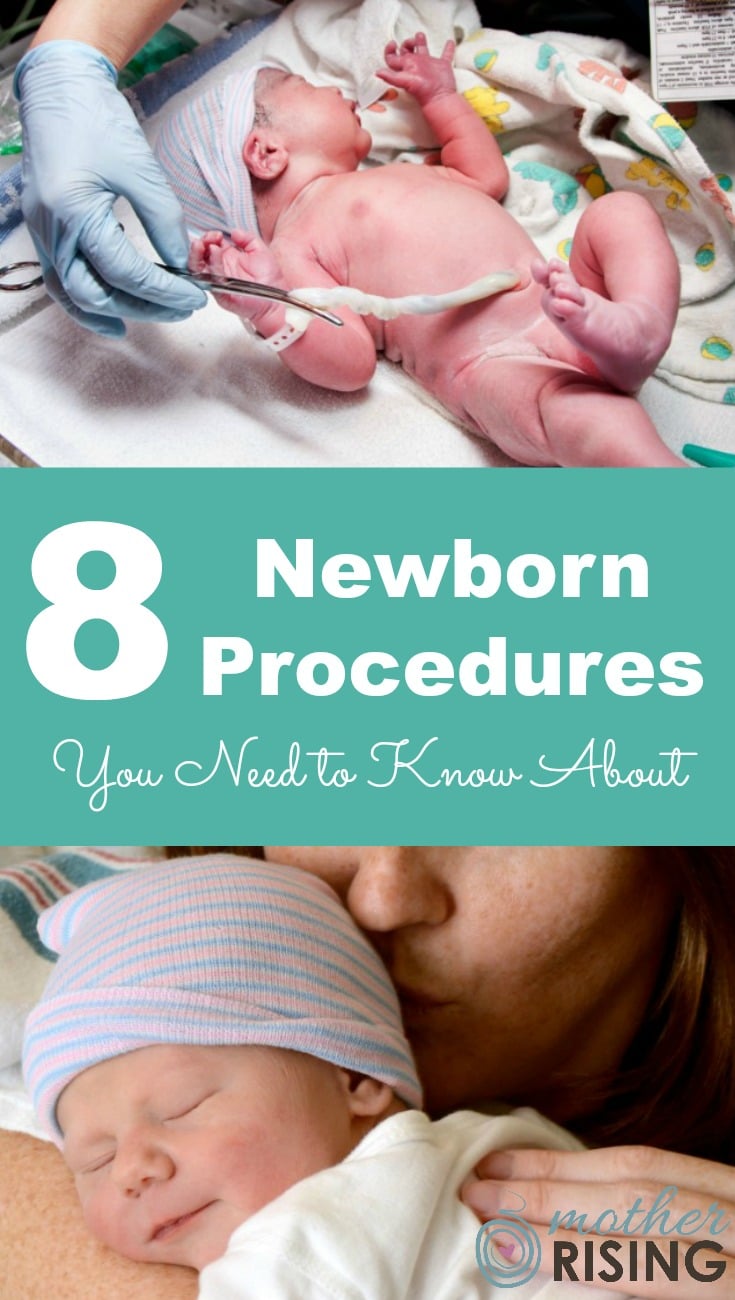
1. Bulb Suctioning
Routine suctioning an infant at birth with a bulb syringe is pretty standard across the board, at least in hospitals. However, this practice has not been found to beneficial for all babies.
In fact, babies that are left alone, or simply wiped with a receiving blanket, have lower/normal heart rates and higher oxygen levels. This tells me that babies transition better to breathing room air when left alone and that bulb syringe suctioning should be reserved for infants that actually need it.
(I’ve often wondered how suctioning affects a baby’s desire to breastfeed. The more vigorous and lengthy suctioning, I would imagine, would be even more disrupting to the breastfeeding process. This proved to be true for a doula client of mine. Her baby endured deep suctioning and then had severe breastfeeding complications.)
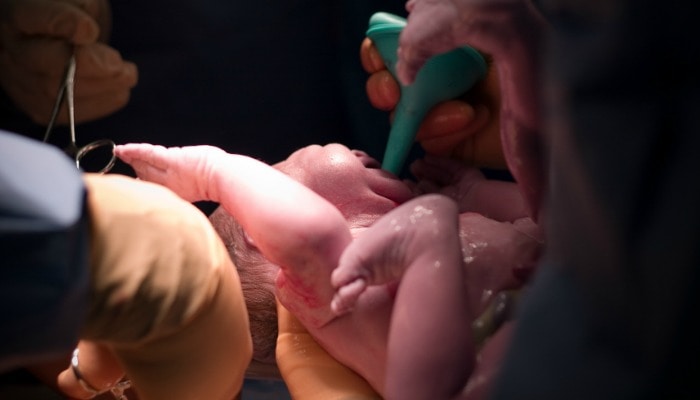
2. Immediate Cord Clamping
Immediate Cord Clamping is the practice of immediately cutting a newborn’s umbilical cord instead of delaying cutting it after birth.
To some, delayed cord clamping may seem like a “crunchy” thing to do or one of those “birthing fads” but if you think about it, delayed cord clamping was normal protocol long before women could be even considered crunchy. In fact, humans are the only mammals that immediately cut the cord after birth. Dogs, cats, horses, elephants, etc. all seem to have better things to do than to sever the umbilical cord after their baby is born.
Fortunately, the AAP and ACOG now back the practice of delayed cord clamping and have encouraged care providers to leave immediate cord clamping behind. Have a conversation with your care provider to discuss their preferred protocol in regards to this practice.
For more information on the benefits of delayed cord clamping, check out my post The Truth About Delayed Cord Clamping.
TIP: Some care providers do umbilical cord milking instead of delayed cord clamping. They’re not the same thing!
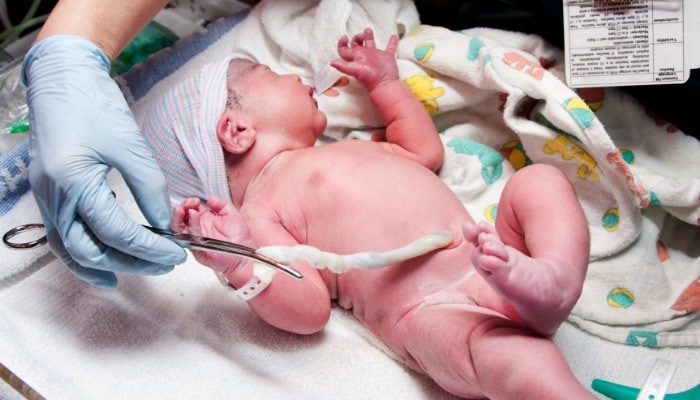
3. Baby Hat
What are a mother’s first instincts when interacting with her freshly born baby for the very first time? She will likely touch, smell, and kiss her baby.
And if a baby has a hat on, she unfortunately smells and kisses a baby hat instead of her baby. I’m going out on a limb here and assume there’s less biological benefit to kissing and smelling a baby hat than a freshly born baby head. 😉
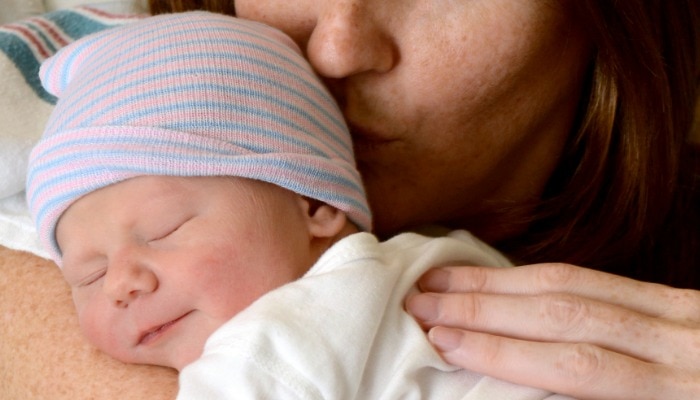
In my brief stint as childbirth assistant, the midwife I was working with was transitioning away from hatting each baby as it was born. She saw the hat as a barrier between the bonding of mothers and babies and desired to eliminate it.
However, thermoregulation still needed to be addressed because the environment to power through transition and pushing (fans, cool breezes, cold a/c, etc.) is not the same environment that keeps a fresh, wet baby warm.
Instead of adding a layer of clothing (a hat) to baby, she dried the baby with a receiving blanket and then altered the environment of the birthing room to accommodate the baby. She turned off any overhead or table fans and adjusted the thermostat to make the environment suitable for a newborn baby.
Also, it turns out that most mothers are super warm after pushing out a baby (pushing is a lot of work!). The perfect place for a new, wet baby to stay warm is with its mom.
I found some research out there in regards to hatting newborn babies. Go figure! The research states that “there were no conclusions drawn about the efficacy of a hat”.
4. Swaddling
Swaddling is helpful because it calms babies and makes them feel cozy just like they were back in the womb. I even teach my childbirth classes proper swaddling technique because swaddling a baby is the first step to calming a baby. But just because something is helpful, does it mean that it’s the best thing right after birth?
If a baby is swaddled that means none of its skin is touching its mother and none of the mother’s skin is touching the baby. What a tragedy!
The photo below looks sweet and all, but the doula in me wants to unwrap that baby and put it skin-to-skin, on mom’s chest STAT!
In my opinion, babies should be swaddled only if they are not being held, which shouldn’t be the case during that first hour. If baby gets swaddled and handed to you, simply unswaddle and place baby on your chest. Again, the best place for baby to be is on mom’s chest, skin-to-skin.
SIDE NOTE: After my one and only hospital birth, I remember waiting as the nurse weighed and measured Mercy. Girlfriend took FOREVER and the mama bear in me was beginning to get feisty. At the end when she was wrapping things up, she began dutifully swaddling up my brand new baby. I told her to stop and just hand me the baby. She didn’t listen but after I insisted, she bewilderingly handed my baby to me. Unswaddle the newborns! Hand them to their mamas!
TIP: Skin-to-skin contact can absolutely happen in the OR. For family friendly tips for cesarean births, check out my post Gentle C Section: How to Experience a Gentle Cesarean.
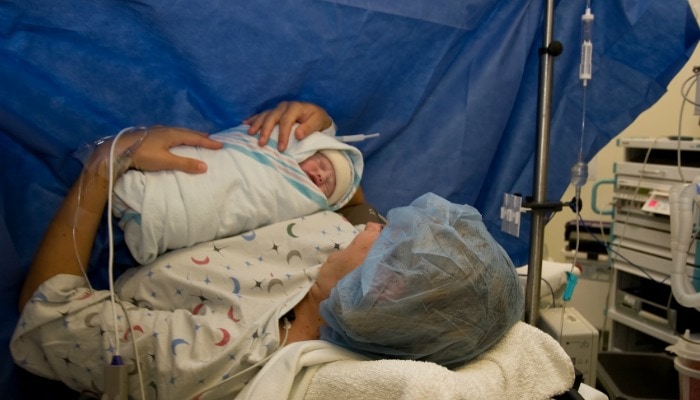
5. Erythromycin Eye Ointment
Erythromycin eye ointment is standard for all newborn babies across the board. This ointment prevents them from contracting an eye infection most often caused by an STD. It’s administered soon after birth – sometimes within the first hour and sometimes after.
“Newborns receive erythromycin eye ointment after birth to prevent pink eye in the first month of life, also called ophthalmia neonatorum (ON). The most common cause of ON is chlamydia, a sexually transmitted infection.” (SOURCE)
If you have been tested negative for these STDs during the first trimester and are in a monogamous relationship, odds are you can skip the eye ointment. Discuss your options with your care provider – they know you and your baby better than I!
TIP: If you decide to go ahead with the erythromycin eye ointment, request it to be administered while baby is on your chest (after the first hour). The heated lights of the baby warmer mixed with the ointment can be irritating to their eyes.
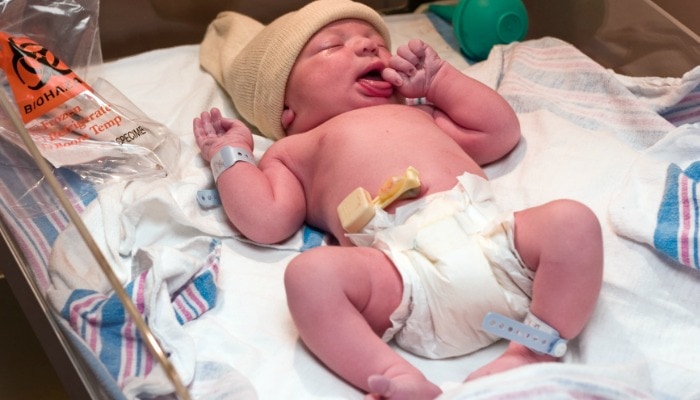
6. Weight and Measurements
“Baby’s here! It’s a boy!”
Without fail, the next question is always…
“How much does he weigh?”
I get it. A baby’s weight and other measurements help strangers get acquainted with this brand new little person that never has existed before. With these statistics, loved ones begin to guess who he takes after, reminds you of, what size clothes he wears, etc.
However, on the list of important activities to accomplish in that first hour, weight and measurements just isn’t that high of a priority. Breastfeeding and bonding take center stage, much to the grandparents disappointment.
But no worries, babies are just as tall a few hours after birth than they are a few minutes after birth. It can wait!
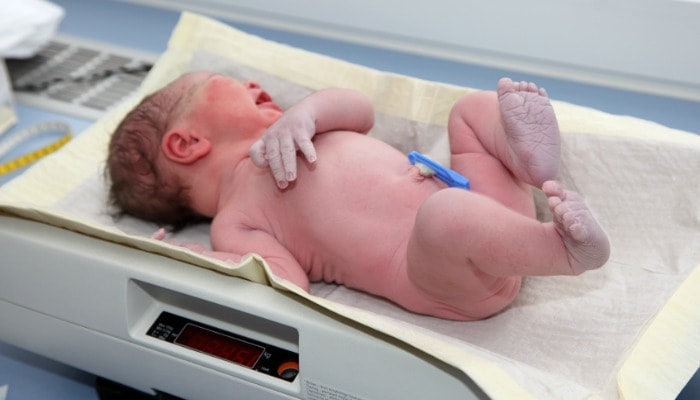
7. Baby’s First Bath
Back in the day when my local hospitals weighed, measured, administered medications, and bathed the babies within the first hour the babies responded the best way they knew how – they screamed, cried and were PISSED OFF. It was hard for me to watch.
These days, after a more baby friendly shift, the bath and other routine newborn procedures are delayed until after the first hour. And guess what? Guess how these babies responded differently?
The babies that are left alone with their mamas to breastfeed and snuggle and THEN bathed are SO CHILLED OUT. They just lay there in their warmer blissed out and generally allowing whatever procedure to be done. It’s truly amazing to watch the differences in behavior.
But back to the bath.
Interrupts Breastfeeding
Bathing a baby within the first hour is so disruptive to the normal progression of things. A bath upsets/overstimulates the baby and when he goes back to mom he is exhausted and disinterested in nursing. What a wasted opportunity!
Lowers Temperature
Babies bathed within the first hour are more susceptible to their body temperature dropping too much. And if they can’t get it back up high enough guess where the baby goes… Back in the warmer, away from mom. Also, when a baby has to regulate their own temperature it lowers their glucose levels. Not cool!
Removes Vernix
As if you needed another reason to delay baby’s first bath, according to this study, too early of a bath can actually leave baby vulnerable against some pretty scary bacteria.
“Early bathing of the baby removes vernix, which contains antimicrobial proteins that are active against group B. streptococcus and E. coli. Delaying the bath and keeping the newborn together with his or her mother until breastfeeding is established may prevent some cases of devastating infections caused by these bacteria.” (SOURCE)
When Can I Bathe Baby?
But aren’t babies dirty? What if they have “stuff” on them after birth? In all my years I’ve only seen one baby that was truly dirty. He was covered in thick meconium and truly needed a bath STAT. Other than that, you’d be surprised at how fresh and lovely these infants are.
The World Health Organization recommends delaying a bath until 24 hours after birth. I say give the baby its first bath within the first week. 😉
TIP: Please don’t use Johnson and Johnson baby soap on these fresh new babies. Their skin is extremely sensitive. Extremely. If you need to use soap I’m a fan of Earth Mama Organics Angel Baby Body Wash. It’s safe and smells great!
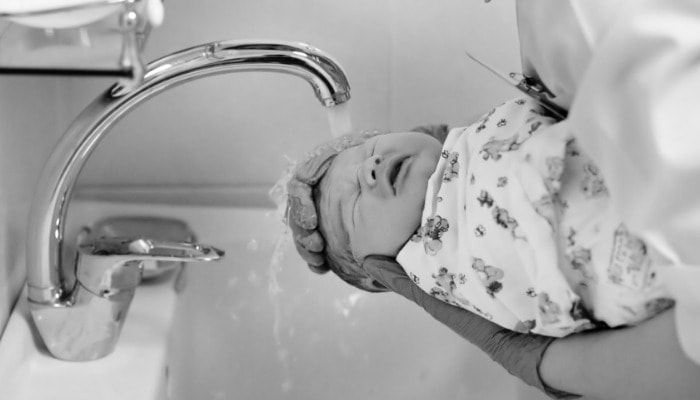
8. Passing the Baby
Last on this list of routine newborn procedures is passing the baby, a big pet peeve of mine. It really irks me when brand spanking new babies are swaddled and passed around the room to meet their fabulously excited new friends and family members. Now, I’m not talking about one day old babies or even five hour old babies, but freshly born babies – especially less than one hour old.
Maybe new parents don’t think much of it, or maybe they feel too intimidated to say no to these well meaning visitors. But it’s such a disappointment for me to watch babies be doted on by grandma instead of their own mother.
Everyone can wait. You’ll never get that first hour back! And if you’re too afraid of enforcing this rule on visitors take advantage of the doulas, nurses, midwives and doctors in the birth room. They’ll help you out!

8 Routine Newborn Procedures You Need to Know About
To recap, these are the 8 routine newborn procedures you need to know about. Have a conversation with your care provider, discuss your options and make a plan. You can do it!
- Bulb Suctioning
- Immediate Cord Clamping
- Baby Hat
- Swaddling
- Erythromycin Eye Ointment
- Weight and Measurements
- Baby’s First Bath
- Passing the Baby


Holly
Thursday 24th of December 2020
Love all of these!! Anytime I hear friends say they are having more people in the room other than dad. Or if dad isn't around 1 other person I tell them to think real hard about it because you will only have that time alone once. After our first we made it a rule no visitors the first day. We love this rule not only to allow moms the time to rest but also to give the parents and baby time to adjust.
Libby
Saturday 4th of January 2020
Louise Whitehead - You are frightening and not at all a "healer." I pity your victims !
Andrei
Wednesday 27th of March 2019
Hi just letting you know in any animal birth the cord is severed as they come out , there is no delayed cord clamping . Calves drop and they are free , same with horses and with cats n dogs the sac gets eaten by mom right away ( not for health benefits like everyone thinks but for safety / predator issues )
Louise Whiteside
Friday 30th of November 2018
seriously? after 1 (ONE) Hospital birth you come to all of these conclusions? I have been a L^D nurse since 1989, have well over 200+ births under my belt, then went on to found Doula Business' in CT and in N. Colorado. Then going on to Midwife school. You need some more schooling kiddo....... 1. Why cord clamped? because too much can be a leading cause to high bilirubin, causing jaundice. 2. No hat? Newborns CANNOT regulate their temperature as they just transition from coming in a constantly warm 'oven', to the outside world. The head, the TOP of the head actually is the biggest loss of heat in newborns. You never want a baby to become chilled. MANY delivery units now do place baby directly on mom's belly/chest and are rubbed clean of vernix there and placed under a warming blanket.......the silver kind you get in many car emergency kits. 3. I do agree the first hour is important, HOWEVER, MANY babies do not adjust to immediately breathing and functioning immediately after birth. Unless something isn't exactly perfect (and a baby with a 9/9 apgar score even) that baby needs to go under a warmer and be given a first immediate exam, to make sure they are getting oxygen not only into their lungs but down into their extremities as well.......(pinking up), and listening to the heart to make sure that the valves have all closed......The eye ointment needs to be given before 1 hour to make sure the bacteria (whether mom was tested at the beginning or middle or end of her pregnancy) has been used a long time. It has been changed to an antibiotic ointment that does not burn the eyes.....it might make eyesight a bit blurry for a while but that doesn't hinder a baby's smell of its mother which is the largest bonding factor. Many mammals do not 'see' for well into 3-4 weeks of age. A Human baby doesn't develop sharp realization eyesight until after first 2 weeks and distinguishing colors. shapes etc not until 2 months.
I feel sorry for your Doula Clients and the Nursing Staff and DR that you are in contact with as you are really not that informed to the why's and where's with your limited experience. You need to have at least a 6 month internship with an Experienced Nurse/Doula/Midwife.
Desiree
Friday 19th of July 2019
This comment is what makes people want to RUN from giving birth with nurses like you. ♀️
Hayls
Sunday 1st of April 2018
I'm a maternity nurse in Canada and as per our health authority's standards and protocols... 1. Bulb suctioning is no longer supported. You can't even find one in our hospitals! 2. Delayed cord clamping is the norm (>3 mins) unless the babe needs support immediately. 3. We do put hats on the babe's head (that are knitted by lovely volunteers) but moms are free to remove them to kiss/smell as they wish. 4. We don't swaddle because of it's increased risk of SIDS. 5. The erythromycin ointment is currently being reviewed by the Canadian Pedatric Association and we expect it to be discontinued soon! That being said a majority of the low risk moms give informed refusal - and we support their decision. 6. Immediate skin to skin with mom (or surrogate if mom isn't able) for at least an hour or until the first feed is finished is protocol- we absolutely do not weigh/measure babe during this time! 7. Baby's bath is delayed until after 24 hours unless the parents wish otherwise (cultural and religious preferences). 8. We support families for their individual birth and postpartum care wishes, however we strongly encourage mom and babe to be left skin to skin for at least an hour!
I know that there are differences in practice depending on country etc however I've read too many articles about the same "8 things" to not comment. Nursing practice is continuing to change and reflect a more baby friendly approach - let's give the medical community a little credit afterall, we are here to support your birth and not destroy it!
Sophie
Thursday 3rd of May 2018
Well stated. I too am a postpartum RN, and our approach reflects your practices in Canada.....baby friendly. We don’t even use pacifiers anymore, and Circumcision are becoming less frequent as new research suggests the medical benefits aren’t as significant as once thought.